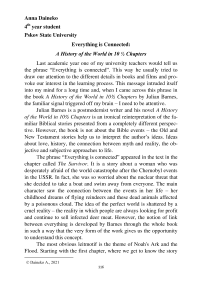Everything is connected: a history of the world in 10 1/2 chapters
Автор: Daineko Anna
Журнал: Тропа. Современная британская литература в российских вузах @footpath
Рубрика: Students' essays
Статья в выпуске: 14, 2021 года.
Бесплатный доступ
Короткий адрес: https://sciup.org/147235581
IDR: 147235581
Текст статьи Everything is connected: a history of the world in 10 1/2 chapters
Last academic year one of my university teachers would tell us the phrase “Everything is connected”. This way he usually tried to draw our attention to the different details in books and films and provoke our interest in the learning process. This message intruded itself into my mind for a long time and, when I came across this phrase in the book A History of the World in 10 ½ Chapters by Julian Barnes, the familiar signal triggered off my brain – I need to be attentive.
Julian Barnes is a postmodernist writer and his novel A History of the World in 10 ½ Chapters is an ironical reinterpretation of the familiar Biblical stories presented from a completely different perspective. However, the book is not about the Bible events – the Old and New Testament stories help us to interpret the author’s ideas. Ideas about love, history, the connection between myth and reality, the objective and subjective approaches to life.
The phrase “Everything is connected” appeared in the text in the chapter called The Survivor . It is a story about a woman who was desperately afraid of the world catastrophe after the Chernobyl events in the USSR. In fact, she was so worried about the nuclear threat that she decided to take a boat and swim away from everyone. The main character saw the connection between the events in her life – her childhood dreams of flying reindeers and these dead animals affected by a poisonous cloud. The idea of the perfect world is shattered by a cruel reality – the reality in which people are always looking for profit and continue to sell infected deer meat. However, the notion of link between everything is developed by Barnes through the whole book in such a way that the very form of the work gives us the opportunity to understand this concept.
The most obvious leitmotif is the theme of Noah's Ark and the Flood. Starting with the first chapter, where we get to know the story
of Noah's Ark on behalf of the woodworm, which is also the interlink of the book, we can trace the appearance of these topics in almost all chapters. If in the first chapter called The Stowaway Noah's Ark appears to us as something objective, then in the process of reading we come across a reference to the ark as a metaphor: the ark as relationships - it can both save you or throw you into the depths of the ocean and make you completely devastated and unhappy; the ark as an unattainable dream of an objective religion understanding; after all, the ark as a metaphor for history: everyone has their own version of historical events. The author reminds us that the world is not something existing separately as well as people living here. Each of us is the representation of the opinions, views and preferences formed by every aspect of the life around us: people, books, myths. Events in Barnes’ book are connected by the tiny woodworm living in the ark and being an “anchor” showing us the connection between the chapters and, of course, the real-life scenes.
And despite the fact that the events in each chapter take place at different times, and sometimes even in the hero's dream, we can easily see the connection between them: each concept can be interpreted in its own way. Was Noah a good man or an arrogant alcohol abuser? Can a person live in the belly of a whale for 3 days or is it just a myth? Should a person blindly follow the laws of his religion or always look around? Julian Barnes replies, “Think for yourself”. Personally, I think this is the most important lesson taught by the author – there are no answers. We must be careful and analyze any information, and, at the same time, we shouldn’t try to understand everything literally. What matters is the lessons we can learn from reading the Bible as reflected in the novel. What is important is not a specific historical date, but the conclusions that we can draw. The fact is, you can look at any event from different angles.
Julian Barnes did not leave me indifferent, reminding me of the versatility of life. Each era sees the world differently; postmodernists teach us to rethink the events of the past. And though their approach is not the right or wrong one, Barnes gave me a reason to change the angle of perception.


